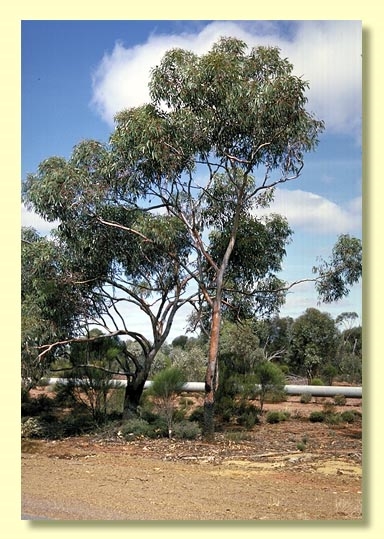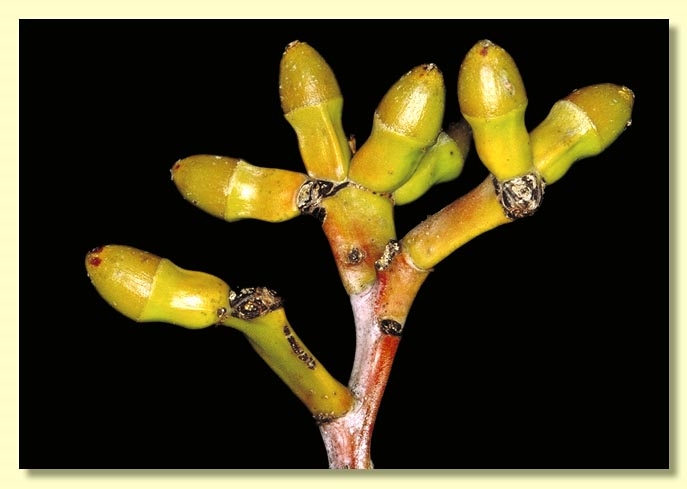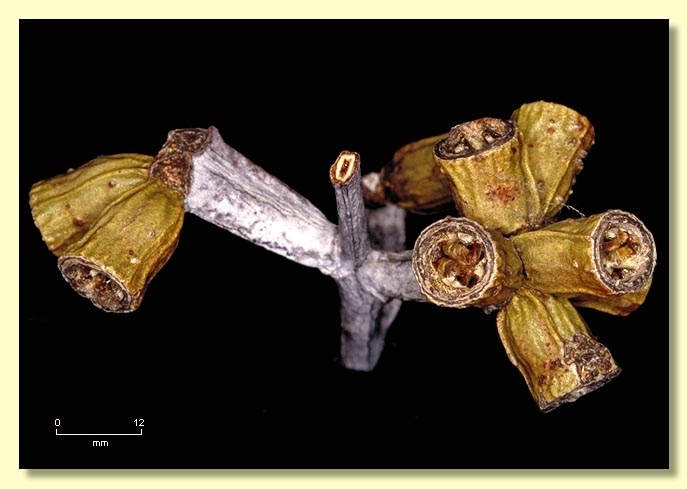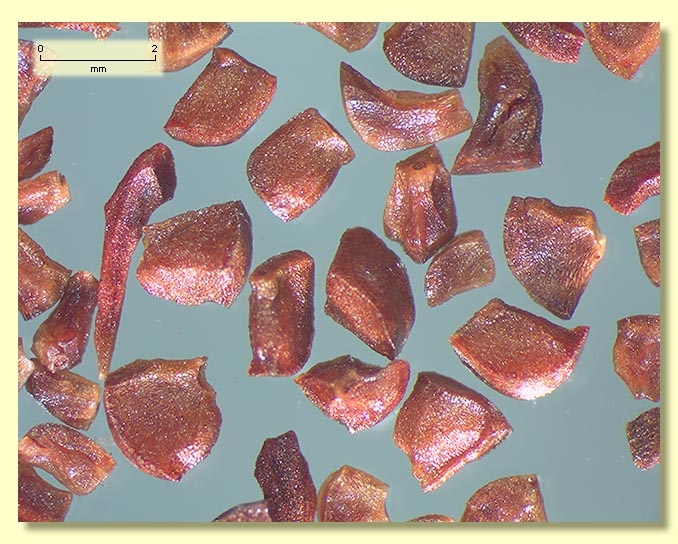Euclid - Online edition
Eucalyptus stricklandii
Eucalyptus | Symphyomyrtus | Bisectae | Glandulosae | Stricklandianae
Bark rough for basal part of trunk, crumbly to flaky, grey-black and red-brown.
Branchlets glaucous, pith with oil glands.
Juvenile growth (coppice or field seedlings to 50 cm): stems rounded to square in cross-section, glaucous; juvenile leaves always petiolate, opposite for ca 5 to 7 nodes then alternate, ovate, 10–15 cm long, 6–8 cm wide, base truncate to rounded or tapering to petiole, grey-green to green, dull, thick.
Adult leaves alternate, petioles 2.3–4.3 cm long; blade lanceolate to falcate, 10.5–18.5 cm long, (1.5)2–3(3.7) cm wide, base tapering to petiole, margin entire, apex pointed, green, glossy, thick, side-veins greater than 45° to midrib, reticulation dense, intramarginal vein remote from margin, oil glands very irregularly shaped, intersectional or more or less obscure.
Inflorescence axillary unbranched, peduncles broadly flattened, glaucous, 1–2.8 cm long, buds 7, conspicuously non-glaucous, sessile or sometimes the base of the bud contracted to resemble a pedicel to 1 cm long. Mature buds 2–2.5 cm long, 0.8–1.2 cm wide, hypanthium cylindrical but flared just below the join, scar present, operculum bluntly conical to rounded, stamens usually inflexed but occasionally some outer stamens only terminally deflexed, anthers narrowly oblong, versatile, sub-basifixed, dehiscing by longitudinal slits, style long and straight, stigma blunt to rounded, locules (3)4, the placentae each with 4 vertical rows of ovules but with a median gap. Flowers yellow.
Fruit sessile, campanulate, 1–1.8 cm long, 1–1.5 cm wide, disc vertically descending, valves (3)4, at rim level or exserted.
Seeds brown to red-brown, glossy, 1.5–2.2 mm long, pyramidal, with two seedcoats, dorsal surface smooth, hilum terminal.
Cultivated seedling: cotyledons Y-shaped (bisected); stems square in cross-section, slightly warty; leaves robust, always petiolate, opposite for 4 to 7 nodes, then alternate, ovate, 10–12 cm long, 5–6 cm wide, base tapering, truncate or rounded, margin entire, apex pointed, dull, green to grey-green.
Flowering has been recorded in November and December.
A small tree endemic to Western Australia, occurring south and east of Coolgardie and Kalgoorlie south towards Norseman, with a disjunct occurrence further north between Menzies and Diemals. The bark is rough, dark grey to black on the lower half of the trunk and the adult leaves glossy green, although the whole crown may appear greyish from a distance. Branchlets are glaucous and the pith strongly glandular. Oil glands in the leaves are very irregular. The buds are characteristically flared around the middle.
Eucalyptus stricklandii belongs to Eucalyptus subgenus Symphyomyrtus section Bisectae subsection Glandulosae because the cotyledons are bisected, buds have an operculum scar and the branchlets have oil glands in the pith. Within this subsection (of ca 80 species) E. stricklandii is only closely related to one other species, E. carnei, which has a more northerly distribution. E. stricklandii differs in being a consistently larger tree always with some rough bark, and having larger leaves, buds and fruit than E. carnei. E. stricklandii has yellow flowers whilst E. carnei has creamy white flowers.
Eucalyptus stricklandii is very popular in cultivation in drier parts of southern Australia, often seen in roadside plantings and parks in country towns.













